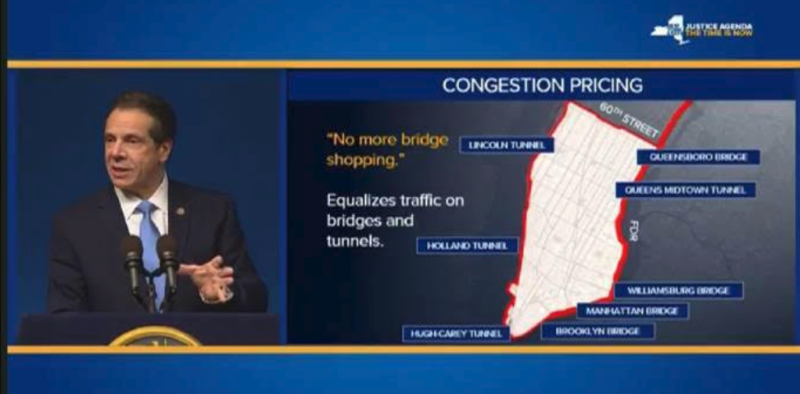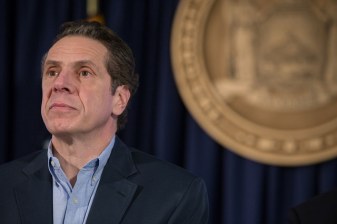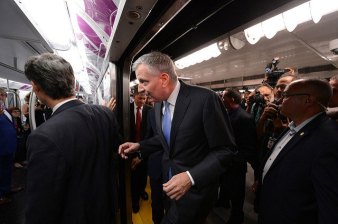Congestion Pricing Can Still Happen in 2021 — But There Are a Lot of ‘Ifs,’ Including President Biden

President Trump’s Department of Transportation has blocked congestion pricing for what experts say are illegitimate political reasons, but advocates are hopeful that incoming President Biden will fast-track the life- and transit-saving Manhattan tolls so that they can still start in 2021.
No, really.
How would such a thing — a glide path for tolls that have been stalled by US DOT since April, 2019 — even be possible? And what is the most optimistic timeline? And is that optimistic timeline possible even with “Amtrak” Joe in the Oval Office?
That’s a lot of questions. Here are the answers:
First, the background
Congestion pricing became state law in April, 2019 — with a timeline that would have created the tolls as soon as January, 2021.
But work needed to be done — specifically, the state needed to conduct either a formal environmental-impact statement or a less-formal environmental assessment. Only the federal government could decide which type of review was necessary, so MTA Chairman and CEO Pat Foye and city DOT Commissioner Polly Trottenberg met with US DOT Secretary Elaine Chao that same month to discuss which environmental review the feds would require.
Two months after that meeting, the MTA sent the Trump administration the preliminary schedule below (which Streetsblog obtained via a Freedom of Information Law request) that said a full environmental-impact statement would take about five months to complete. A less complicated assessment would take about three months, the agency said.

In either case, the MTA’s scenarios were based on the assumption that the feds would decide which review they wanted by August, 2019.
But the feds did not decide by August, 2019.
In fact, in October, federal authorities asked the MTA about revenue anticipated by the congestion cordon and how the price of the tolls could influence “driver behavior.” The MTA answered those questions by January, 2020 (which the Federal Highway Administration confirmed to the New York Times). At the time, the feds said they had received all of the information they requested from the MTA.
It is now mid-November, 2020 — roughly 19 months since Foye and Trottenberg met with Chao, roughly 13 months since the feds asked for final information from the MTA and roughly 11 months since the US DOT confirmed it had gotten everything it needed to make a decision on the simple question of what kind of environmental review it needs before rubber-stamping a fairly non-controversial toll that would not actually cost the federal government anything.
Yet the US DOT still has not told the state what kind of environmental review it wants.
It’s Joe time
Unless a lame-duck President Trump changes course, the soonest that the federal government could offer its instructions to the MTA would be upon the inauguration of President Biden on Jan. 20, 2021 (although the incoming president has a long list of “Day One” plans).
President Biden has two immediate options:
- He could issue an executive order exempting congestion pricing from environmental review or outlining what kind of review he wants. (Point of information: Mayor de Blasio has already managed to screw that one up by saying congestion pricing should be lower down on the new president’s agenda, behind a COVID vaccine and a general stimulus. Cuomo’s office did not respond to requests for comment.)
- Biden could wait for his incoming Transportation Secretary — Chao’s replacement — to get up to speed and take over the issue.
The first scenario is unlikely, though MTA Chairman and CEO Pat Foye has said that the positive environmental effects of congestion pricing should exempt congestion pricing from the standard environmental review process. (The Biden transition team did not return a request for comment on whether the incoming president agrees.)
The second scenario requires … the U.S. Senate! Majority Leader Mitch McConnell has already said he will be an impediment to Biden’s picks.
“Biden walks in the door — and it could take four months to get a US DOT secretary,” said Lisa Daglian, the executive director of the Permanent Citizens Advisory Committee to the MTA, who favors the executive order route so that we don’t “wait forever.”
“It has to be a priority for the president to come in and issue an executive order” giving the MTA environmental-review guidance or an exemption, she said.
So either in February, 2021, or whenever McConnell approves President Biden’s cabinet picks, the MTA’s timeline (above) could begin. For the sake of argument, let’s say Biden’s DOT Secretary is confirmed by the end of April.
So given the MTA’s timeline, the three-month environmental assessment or the five-month environmental-impact statement would be done by the end of September in the worse-case scenario. (Point of information: The MTA’s three- or five-month timeline is incredibly optimistic, given that assessments usually take a year and full impact statements can take multiple years, but still…)
“These are very aggressive schedules, but not impossible if everyone is working at full speed and the agencies give review and approval of the documents top priority,” said Michael Gerrard, the director of the Sabin Center for Climate Change and an expert in federal environmental-review processes. “These processes typically take considerably longer.”
So will it happen in 2021?
“Congestion pricing in 2021” is, to be clear, a wildly optimistic take, especially as AAA starts lobbying for a delay (a delay to something that hasn’t started because of delays?). But Daglian believes the MTA has done everything it can to be ready for the federal OK.
“You can’t start putting in the tolling equipment before the OK to do it, otherwise they would start doing it already. My understanding is that those contracts are ready to go, so they’re waiting on the go-ahead. I think it will be 2021, barring any lawsuits or additional hold-ups,” said Daglian.
Foye admits that the revenue from congestion pricing certainly won’t be available until 2022 at the earliest.
“I think it’s clear we believe that the Biden administration will take a different view on the processing of congestion pricing,” he said when asked on Thursday if the MTA could “incorporate congestion pricing revenue into its 2021 budget.” “We’re very hopeful and believe the new administration will have a more enlightened view on the processing of an application that’s been sitting in Washington for 18, 19 months.”
A most optimistic scenario, like an "If Moises Alou stays healthy for a whole year" scenario, could see the whole thing ready to turn on this year, but there's a 60-day gap between going live and collecting money https://t.co/rzIchXtoWI
— Good Idea Dave (@DaveCoIon) November 18, 2020
There’s one thing that the state has not done — and could: It must staff up the Traffic Mobility Review Board, the panel that is tasked with recommending toll prices and exemptions to the MTA Board for approval. The state law that created congestion pricing also created the board — which insulates politicians from being the ones who “set” and raise the toll — and mandated that it issue no report before Nov. 15, 2020, or four days ago, and by Dec. 31, 2020 at the latest.
Or not.
The same state law that created the TMRB included a clause allowing state officials to drag their feet on empaneling the board until “30 days before a central business district tolling program is initiated.” So that particular horse remains behind the larger cart of when congestion pricing will actually be 30 days from starting.
That the TMRB hasn’t met or even been staffed is presumably a way to keep it from setting a toll price that can’t be implemented until a still-undetermined date. But now that the 2020 election is mostly behind us, the TMRB could work on a parallel track with the environmental review process.
“If, say the MTA gets an approval from the Biden administration by February, can it do the EA and the TMRB by July? It seems possible,” said Reinvent Albany Senior Researcher Rachael Fauss. “The election’s over, so whatever political concerns were there around the TMRB are no longer there.”
The TMRB also doesn’t have to convene before an environmental review begins. Any environmental review will cover a range of options for the congestion toll for things like price and a variable vs. fixed toll and the different times of day the toll will operate. If, for example, the MTA assesses the impact of different prices for morning and afternoon rush hour tolls between, say, $5 at a low end and, say, $20 at a high end, a proposed toll of $13 by the TMRB would be a satisfactory end point for the process.
“Even if the tolls proposed by the Traffic Mobility Review Board, the pricing, the time of day, so on, doesn’t exactly match one of the alternatives scenarios that the MTA looked at during the environmental review, if it’s within the range of alternatives they looked at, that typically satisfies the NEPA requirements for having captured what the relative impacts will be from an environmental standpoint,” said Alex Matthiessen, the founder of the Move NY campaign .
Putting things in motion
Beyond a switch in administrations, there are other helpful tailwinds for the MTA nationally, too, thanks to other congestion pricing efforts from potential Biden administration members. The Los Angeles County MTA is now exploring the adoption of congestion pricing, at the same time that Metro CEO Phil Washington (and New York City DOT Commissioner Polly Trottenberg) is on the Biden-Harris transition panel on transportation.
“New York City is the standard bearer for the rest of the country, so LA Metro is certainly looking at what’s going on with this very closely,” said Daglian.
Even with a friendlier environment in Washington, advocates said it was still incumbent upon New York’s leaders to let the incoming president know how important congestion pricing is to the future of the MTA and the New York City region. After all, the $1 billion in tolls it can raise, and then bond out to $15 billion, can be lifeline for the 2020-2024 capital program or, if necessary, stop the bleeding in the basic operating budget.
“All of us in New York City and state who are anxious to see congestion pricing get underway and get implemented need to be using whatever levers of power we have to get this in front of the Biden administration as quickly as possible and towards the top of their priority list,” said Alex Mathiessen, the founder of the Move NY campaign, the original congestion pricing effort in New York City.
But Biden’s abiding (abiden?) interest in infrastructure programs means that he may well see congestion pricing, and other long-stalled priorities like the cross-Hudson Gateway tunnel as part and parcel of a stimulus effort for the city, MTA and the Northeast as a whole. His administration’s interest in “building back better,” investing in resilient infrastructure and intracity rail are exactly the kind of things the region will need help with after all.
So 2021 could be the year congestion pricing finally debuts in New York. But even with as good a chance to get congestion pricing over the hump finally, advocates warned it was too early to start celebrating just yet.
“The last thing we all want to do is get super excited and then it turns out your pony is dead when you open the box,” Daglian said.
The pony won’t be dead, promised MTA Senior Adviser Ken Lovett.
“The MTA is ready to move forward at full speed with congestion pricing as soon as we get the green light on an environmental review from the federal government,” Lovett said. “We’ve already been impatiently waiting for 19 months for Trump officials to advise what process to follow and are hopeful the incoming administration will provide a required road map to approval. In the meantime, we have been doing all we can, including the drafting of a preliminary design, to accelerate forward.”



